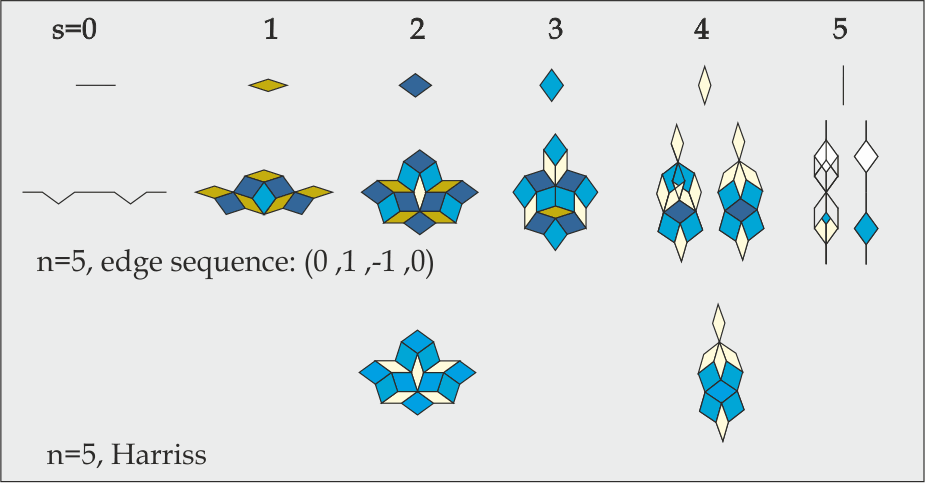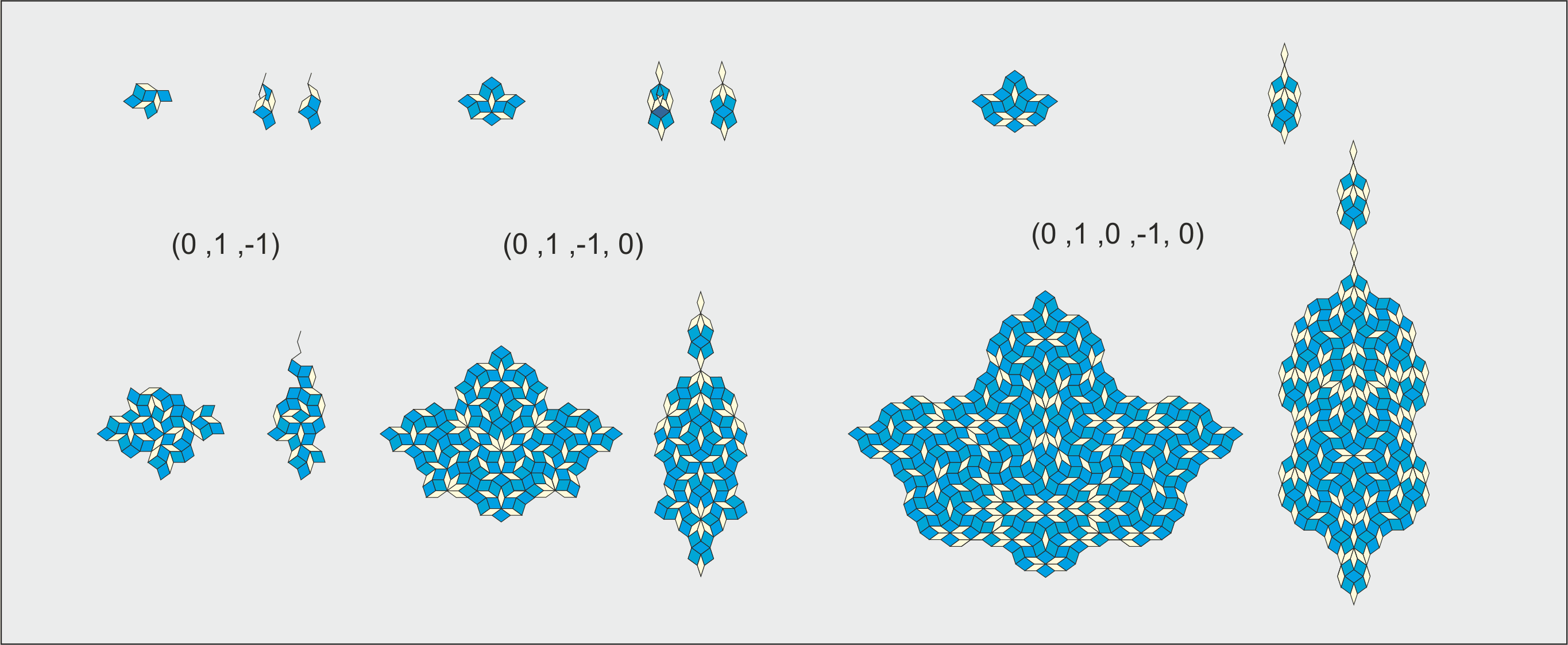A generalization of a rhomb tiling for arbitrary ![]() was introduced by E.O. Harriss. It is based on an edge sequence of
was introduced by E.O. Harriss. It is based on an edge sequence of ![]() . Using our treatment and notation the basic substitution tile matrix for this edge sequence is
. Using our treatment and notation the basic substitution tile matrix for this edge sequence is
(1) 
To reduce the size of the prototile set for odd n, Harriss used a substitution rule in which the ![]() tiles are replaced by the
tiles are replaced by the ![]() tiles or
tiles or
(2) 
Note that the pair of ![]() -tiles in the center have to be rotated over
-tiles in the center have to be rotated over ![]() in order to fit in for higher generations. The twofold rotation is signified by underlining the matrix entry.
in order to fit in for higher generations. The twofold rotation is signified by underlining the matrix entry.
In the figure below the substitution tiles for ![]() are shown for both cases.
are shown for both cases.

 and Harriss’s substitution rule for odd
and Harriss’s substitution rule for odd  and even
and even  .
.To apply the basic substitution rule eq. (1) all possible prototiles, the positive as well as the negative ones, have to be included. The tiles in the ![]() tile can be rearranged to avoid the negative
tile can be rearranged to avoid the negative ![]() tile, but it is not possible to circumvent the
tile, but it is not possible to circumvent the ![]() negative tile in the
negative tile in the ![]() substitution tile. And although not visible the
substitution tile. And although not visible the ![]() tile (a straight line) has to be used in the
tile (a straight line) has to be used in the ![]() substitution tile as will become apparent in the next generation supertiles.
substitution tile as will become apparent in the next generation supertiles.
For odd ![]() , Harriss’s substitution rule separates the prototiles into two groups, the odd and even s prototiles. Formally, the zero area and negative tiles are also involved. Nevertheless, the set of even tiles may be reduced to two positive tiles, the
, Harriss’s substitution rule separates the prototiles into two groups, the odd and even s prototiles. Formally, the zero area and negative tiles are also involved. Nevertheless, the set of even tiles may be reduced to two positive tiles, the ![]() and the
and the ![]() tiles, by neglecting the
tiles, by neglecting the ![]() tile, and by letting the
tile, and by letting the ![]() negative tile annihilate a
negative tile annihilate a ![]() tile and a rearrangement of the remaining tiles. In the set of odd s tiles,
tile and a rearrangement of the remaining tiles. In the set of odd s tiles, ![]() , the
, the ![]() tile has to be used. Because this tile sonsists of congruent negative and positive parts, its role is to move a patch of tiles from a n overlapping to an empty part of the substitution tile. Harriss’s solution was to add substitution tiles with additional or missing prototiles. Our treatment gives the same result, but in a simpler, more straightforward way.
tile has to be used. Because this tile sonsists of congruent negative and positive parts, its role is to move a patch of tiles from a n overlapping to an empty part of the substitution tile. Harriss’s solution was to add substitution tiles with additional or missing prototiles. Our treatment gives the same result, but in a simpler, more straightforward way.
There are many other Harriss-like tilings without negative tiles for edge sequences with one or more ![]() pairs and starting with a 0 to avoid crossing of neighboring edges.
pairs and starting with a 0 to avoid crossing of neighboring edges.
(0 ,1,-1) edge with substitution tile matrix:
(3) 
The right column and last row of the Harriss tile have been removed. The inflation factor is ![]()
(0 ,1 ,0 ,-1 ,0) edge with substitution tile matrix:
(4) 
An extra row and column of prototiles have been added in the middle of the Harriss tile. In this case a rearrangement of the prototiles ![]() is not even needed. The inflation factor is
is not even needed. The inflation factor is ![]() .
.
A second set of substitution tiles with a different edge shape (or substitution tile edge sequence) may be obtained by rotating all prototilesover ![]() in the above Harriss-like substitution tiles.
in the above Harriss-like substitution tiles.
